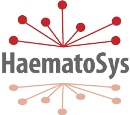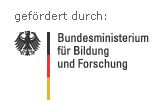HaematoSys
Systembiologie der Hämatopoese und hämatopoetischer Neoplasien
Subproject 3 ¿ Integrated modelling of haematopoietic stem and mature blood cell organisation
Applicants: Ingo Röder (IR), Markus Scholz (MS)
Associated partners: M. d’Inverno (London, UK)
Background and own contributions: Due to specificities of the underlying systems, the organisation of HSC and of precursor/mature cells had so far been modelled by conceptually and methodologically different approaches: a stochastic IBM of HSCs (see SP1) and deterministic, population-based ODE models of mature blood formation (see SP2). Both approaches proved to be useful for particular applications. Whereas the IBM explains clonal competition / fluctuation dynamics in HSC (cell numbers: 1 to 10000), the ODE model accounts for pharmacokinetic/-dynamic effects of growth factors and of cytotoxic drugs in large populations of mature blood cells (cell numbers: 106 – 1012). However, a comprehensive and predictive haematopoiesis model that comprises both, stem cell effects as well as short-term regulations / feedback control originating from mature blood cells, is not yet available.
Objective: We will combine the two models developed in SP1 and SP2 into an integrated quantitative model of haematopoiesis in mice and humans. The integrated model will eliminate the limitations of the separated approaches and extent possible applications. Furthermore, it will contribute to a systemic understanding of the relation between single cell/clone effects and dynamics of large cell populations.
Available data: see SP1 and 2
Working program: In order to combine the two different model classes, it will be necessary to apply techniques of scale translation. The basic structure of the models will be preserved. We will introduce a smoothing mechanism into the stem cell model which defines a scale. The smoothed efflux of this modified stem cell model is the new influx into the differential equations model. Furthermore, the demand of haematopoiesis will be considered in the stem cell model by introducing an appropriate feedback mechanism which influences regulatory processes in the stem cell model. First, we aim at constructing separated models for each lineage without chemotherapy. In the next step, we combine the lineages by the extended HSC model comprising lineage specification (cf. SP1). To derive appropriate model assumptions and to adjust parameters, we will use the experimental data generated in SP1 and 2. In particular, we will exploit the perturbation experiments with respect to single cell stages (using multi-colour FACS sorting). Finally, we model the effect of general chemotherapy in the stem cell model and adapt the chemotherapy effects in the model equations. Again, we aim at constructing a model for the murine system first, which will then be transferred (up-scaled) to the human situation. Alternatively to the described modelling strategy, we will also develop (i) an integrated model transferring the IMB into a partial differential equation model and combining this with the ODE model of mature haematopoiesis and (ii) an agent-based version of the ODE model, which will be combined with the IBM describing HSC organization. All approaches will be compared with respect to their efficiency and accurateness. The criterion for an adequate integrated model is the correct simultaneous description of the experimental phenomena analysed in SP1 and 2.

